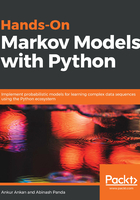
Transience and recurrence
Given that we start at state i, it is called transient if there is a non-zero probability that we will never return to state i. To define this in more formal terms, let's consider a random variable Ti as the first return time to state i:

Let's now define another term,  , as the probability of the system returns to state i after n steps:
, as the probability of the system returns to state i after n steps:

Now we can define that any given state i is transient if the following condition is met:

In the preceding equation, we are basically checking whether the total sum of probabilities of returning to state i in step sizes less than  is less than 1. If the total sum is less than 1, it would mean that the probability of Ti to be
is less than 1. If the total sum is less than 1, it would mean that the probability of Ti to be  is greater than 0 which would mean that the state i is transient. The given state i is called recurrent if it is not transient:
is greater than 0 which would mean that the state i is transient. The given state i is called recurrent if it is not transient:

In the preceding example, we can see that states A and B are transient because A doesn't have any incoming edge. B does have an incoming edge, but it's incoming from another transient state and therefore it is also transient. Hence, once the system leaves state A or B, it won't be able to come back.
It is really simple to check whether a given state is transient or not. We can simply check whether there are any incoming edges from other states or not. If not, the state is transient. Let's write a simple method to check this for our MarkovChain class:
def is_transient(self, state):
"""
Checks if a state is transient or not.
Parameters
----------
state: str
The state for which the transient property needs to be checked.
"""
if all(self.transition_matrix[~self.index_dict[state], self.index_dict[state]] == 0):
return True
else:
return False
Now we can use this method in our example in Figure 1.6 to check which nodes are transient:
>>> transient_matrix = [[0, 0.5, 0.5, 0],
[0, 0, 0.25, 0.75],
[0, 0, 0, 1],
[0, 0, 0.5, 0.5]]
>>> transient_markov = MarkovChain(transition_matrix=transient_matrix,
states=['A', 'B', 'C', 'D'])
>>> transient_markov.is_transient('A')
True
>>> transient_markov.is_transient('B')
True
>>> transient_markov.is_transient('C')
False
In the following subsections, we will talk about the statistical properties of the random variable Ti.